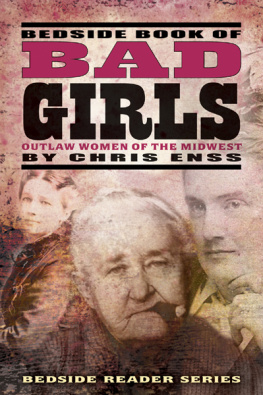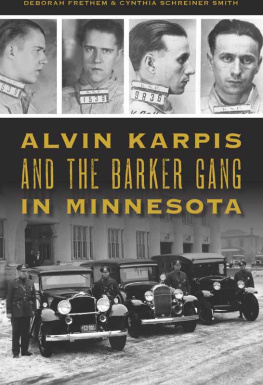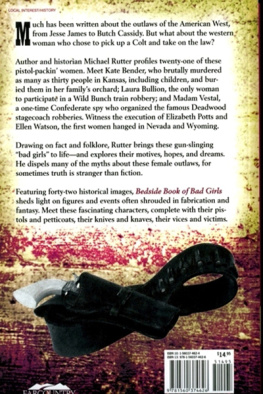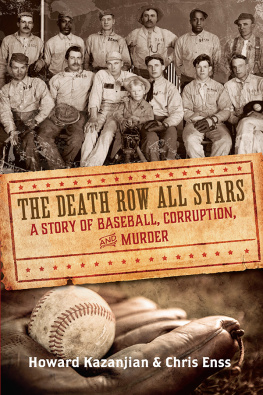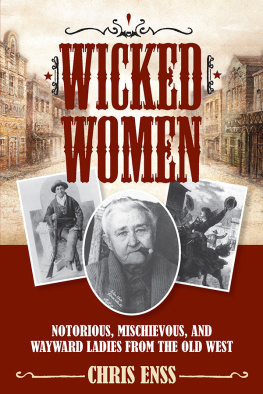
For a print copy of this book, visit www.farcountrypress.com
print ISBN 13: 978-1-56037-525-8
epub ISBN: 978-1-56037-168-7
mobi ISBN: 978-1-56037-169-4
2012 by Farcountry Press
Text 2012 by Chris Enss
Cover photo: Left: Victoria Hull. Special Collections, Vassar College Libraries; Center: Poker Alice of Sturgis. Photo Courtesy of the State Archives of the South Dakota Historical Society; Right: Kate King. Jackson County (Mo.) Historical Society Archives.
All rights reserved. This book may not be reproduced in whole or in part by any means (with the exception of short quotes for the purpose of review) without the permission of the publisher.
For more information on our books, write Farcountry Press, P.O. Box 5630, Helena, MT 59604; call (800) 821-3874; or visit www.farcountrypress.com.
Part of the Bedside Reader series, which includes:
Bad Boys of the Black HillsAnd Some Wild Women, Too
By Barbara Fifer
Upstairs Girls: Prostitution in the American West
By Michael Rutter
Wanted: Wanted Posters of the Old West
By Barbara Fifer and Martin J. Kidston
Bedside Book of Bad Girls: Outlaw Women of the American West
By Michael Rutter
ACKNOWLEDGMENTS
I can only try to thank all those who helped with this book.
First let me express my gratitude to Jeff Galpin, a gentleman graphic artist who went out of his way to help secure the artwork needed for several chapters in this book.
Im indebted to Lauren Leeman at the State Historical Society of Missouri; Paul Ford at Harpers Weekly archives; David Jackson, director of Archives and Education at the Jackson County Historical Society in Missouri; Nancy Sherbert in the Archives Department at the Kansas State Historical Society; Dean Rogers, Special Collections Assistant at Vassar College Library; the staff at the Madelyn Helling Library in Nevada City, California; and finally to Roger Creed in Palestine, Illinois.
From Denver, Colorado, to Independence, Missouri, so many knowledgeable people offered their expertiseassisting during my onsite research. They provided valuable historical documents to use in writing this book, and generously offered to help in tracking down hard-to-find information. To all I humbly say, Thank you. 
INTRODUCTION
T his edition of the Bedside Book of Bad Girls chronicles 110 years of Midwestern banditry. This lawlessness was spawned in part by the Civil War and finally checked by the Federal Bureau of Investigation. Some outlaws, such as Frank and Jesse James and the Younger Brothers, blamed the oppressive troops of the Union Army as a reason for their wrongdoings. They claimed that Southern sympathizers were treated poorly after the war and denied the chance to earn an honest living. Ma Barker and her boys felt similarly afflicted by the federal government. They insisted that they were unable to secure legitimate work because authorities were always accusing them of major crimes.
A shocking array of high crimes and misdemeanors committed in such places as North Platte, Nebraska; Lawrence, Illinois; Labette County, Kansas; and Joplin, Missouri; were perpetrated by women. Whether wicked by nature or choice, the renegade women profiled in this bookand those whose names have been lost to historyresisted living law-abiding lives. Tales of historys bad girls and outlaw women are not as well publicized as those of Joaquin Murrieta, John Wesley Hardin, the James Brothers, Benjamin Bugsy Siegel, and Meyer Lansky, but they are no less stirring, and their illegal exploits are as riveting as anything their male counterparts carried out.
The American Midwest was a place of great opportunity during the nineteenth century, teeming with explorers, farmers, missionaries, trappers, and traders, all striving to carve out a living for themselves. Homesteaders, ranchers, shop owners, and railroad executives established towns and cities that dared to reach beyond the boundaries of the Mississippi River toward the Pacific Ocean. Outlaws stalked the region as well, taking advantage of cowboys coming off the trail; immigrants passing through on stagecoaches, wagons, or trains; and disenfranchised Native Americans trying to hold on to their land.
By the mid-1930s, the American Midwest had progressed substantially. Automobiles replaced Conestoga wagons, and the sod houses pioneers called home were replaced with brick and mortar. Ambitious settlers had transformed small communities like Minneapolis, Minnesota; St. Louis, Missouri; and Chicago, Illinois; into bustling metropolises. Hardships, however, came with the advancements. A devastating drought brought the Dust Bowl, and a severe economic downturn thrust the country into the Great Depression. Outlaws again took advantage of the desperate times.
Among the notorious bad guys who robbed, swindled, and murdered Midwesterners from 1824 to 1936 were a number of bad girls who could be just as dishonest and violent. Female fugitives such as Flora Mundis, a horse thief and prostitute, were motivated by poverty, lack of opportunity, discontent, and a desire for adventure. Others, such as serial killer Kate Bender, were driven by a cold-blooded, cruel character that made them ruthless and inhumane. Some, such as Sarah Quantrill, became wanted women by association; these ladies harbored their outlaw lovers and aided them in their criminal behavior.
Just as male outlaws experienced retribution from the long arm of the law, female criminals paid a price as well. Federal agents and local authorities tracked lady desperados to their hideouts and arrested them. Some received fair trials and served time or were executed. Others were killed on the spot for their misdeeds.
In writing the stories of these lawless females for this book, every attempt was made to separate legend from truth. Newspaper accounts and oral interpretation of events passed down from generation to generation make that mission impossible at times. Women outlaws were intriguing to dime novelists and reporters, and their exploits were often exaggerated to make the women and their crimes more sensational.
In addition to sifting through actual events and outlandish claims, historians write from the dim distance of decades. Dates and broad particulars can be argued. What is not debatable is that these women contributed to the criminal history of the dashing days of the wild and woolly Midwest. 
CHAPTER ONE
FLORA MUNDIS
Lady Horse Thief

T om King followed five spirited, fast-moving horses into a dense line of trees seven miles outside the town of Fredonia, Kansas. It was a stifling hot August day in 1894. Low-hanging branches on brown, thirsty trees slapped at the criminal and his horse as they sped by. Sweat foamed around the animals neck and hindquarters. Tom, dressed in worn trousers, chaps, a flannel shirt, a large-brimmed hat, and a tan duster, skillfully maneuvered his ride around fallen limbs in pursuit of his quarry.
Tom and his roan were directly beside the five horses as they broke through the other side of the grove of trees. His horse leapt over a cluster of large boulders; Tom leaned back in the saddle to let the wind strip off his coat as his horse jumped. In that moment Tom and the horse were in midair, and the coat trailed behind him like leather wings.
Next page
